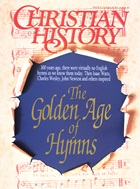The Church of England did not officially approve the singing of hymns in worship until 1820. For nearly one hundred years, Dissenters and Methodists had been singing hymns. Why was the Church of England so slow to recognize the power and usefulness of “hymns of original composition” ?
Would-Be Revolutionaries
We easily forget that hymns were written and sung by men and women who lived their lives and practiced their faith on the margins of conventional English Christianity. Anglicans resented, even hated, Dissenters [those who separated from the established Church of England] and Methodists. Thus, hymn singing, which Dissenters and Methodists practiced, came to stand for all that was wrong with non-orthodox faith.
Isaac Watts was a Dissenter, a Calvinist who believed in congregational autonomy or “Independence.” While Watts was a loyal British subject, he and fellow Dissenters accepted many of the principles that had led to the Civil War in England. Anglicans had not forgotten the killing of Charles I and the establishment of the Puritan Commonwealth under Oliver Cromwell.
During the Restoration Period (1660–1700) Calvinist Dissenters were widely regarded as would-be revolutionaries, eager to upset the peace and return England to its Puritan past. Dissenters were, accordingly, heavily persecuted, subject to fines and imprisonment. They were excluded from public employment and the university. In Absalom and Achitophel (1681), John Dryden describes the Dissenters as rabble-rousing demagogues, determined to destroy the monarchy. Thus, when the Dissenters sang hymns, those hymns were often associated with Christian extremism and even revolutionary politics.
Brawlers and Brayers
John and Charles Wesley, however, were upstanding university M.A.’s, ordained ministers of the Church of England. Charles even discouraged his brother from any move that might lead to a break between Methodism and the established church. Aristocratic friends and supporters within the church made Methodism seem acceptable.
Yet the Evangelical Revival associated with the Wesleys seems to have raised two kinds of fears. Both reflected on congregational hymnody.
Fear of the mob: The first fear was of the vast mass of unwashed, uneducated common people. The Wesleyan congregation seemed a mob. Any mob was volatile, prone to riot, threatening life and property and the precious social order.
Fear of “enthusiasm”: Anglicans disliked irrational religion. Private inspiration bred individualism and heterodoxy. The Wesleyan journals, indeed, reflect the array of sectarian possibilities that “revived” communities fell prey to—Moravian, Calvinist, Quietist, and “prophetic.” The hymns themselves, as they center in profound conversion, expressing intense emotion, are “enthusiastick.”
In A Fine Picture of Enthusiasm (1740), John Scot described early Revival hymnody as irrational: “The Hymns they sing, i.e. all I have seen or heard of, are not rational Compositions, nor do they accord with the first Principles of all Religion, but like their Prayers, dwell upon a Word, or are immediate addresses to the Son of God, as the supreme Object of Worship. And do represent him as much more friendly and compassionate to the human World than God the Father ever was—so that their Singing is calculated to engage the Passions by nothing more than Words, and the Melody of the Sound, or Voice; but if you would sing with the Understanding, you must have other sorts of Compositions both for Psalmody and Prayer, than what the Foundery or the Tabernacle [Methodist meeting halls] do afford you.”
When he defended hymns in 1757, John Wesley addressed this fear of unreason, claiming of his people that “When it is seasonable to sing praise to GOD they do it with the spirit and with the understanding also … in psalms and hymns which are both sense and poetry.”
Entering the Mainstream
Hymns were eventually accepted into Church of England worship. Indeed, the future lay with hymns and the political developments that nurtured them. Through Watts’s agency, Dissenting educational theory was institutionalized at Harvard and Yale. In both America and in England, the frightful mob led eventually to democratic government. Christian “enthusiasm,” dissociated from political revolution, lost its terror and entered the mainstream, where it remains to this day.
Dr. Madeleine Forell Marshall is on the faculty of the University of San Diego and of California State University at San Marcos. She has taught literature at the University of Puerto Rico, the Lutheran School of Theology at Chicago, and St. Olaf College. She is co-author, with Janet Todd, of English Congregational Hymns in the Eighteenth Century (Kentucky, 1982).
Copyright © 1991 by the author or Christianity Today/Christian History magazine.
Click here for reprint information on Christian History.

Support Our Work
Subscribe to CT for less than $4.25/month





























